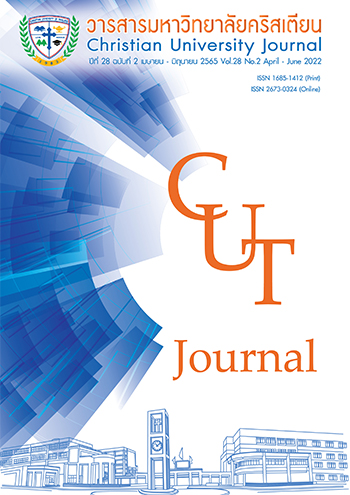[Retraced Article] Factors Predicted Electric Smoking Among Male Vocational Students in Buriram Province
Keywords:
Predictive factors, Electrical cigarette, Adolescent, E-smoking experienceAbstract
The objectives of this analytical cross-sectional study were to identify prevalence and factors predicting electric smoking (e-smoking) among male vocational students. The sample consisted of 338 vocational students in Buriram Province using a multi-stage random sampling to recruit the sample. Data were retrieved by self-administered questionnaires including demographic data, smoking, attitude towards e-cigarette smoking, smoking law perception, school relationship and stress. Multiple logistic regression was performed to investigate the relationship between various factors and E-smoking. The overall prediction property of the final model was also examined using receiver operating characteristics (ROC) curve.
The results showed that the prevalence of e-smoking was 59.8% (95%CI: 54.3-65.0). Factors that significantly associated with e-smoking among male vocational students were peer-persuasion to smoke (AOR=3.81; 95%CI: 2.29-6.35), peer E-smoking (AOR=3.03; 95%CI: 1.78-5.18), school relationship (AOR=2.60; 95%CI: 1.54-4.38) and peer cigarette smoking (AOR=2.43; 95%CI: 1.41-4.21), respectively. The area under ROC curve of this final model was 80.0% (95%CI: 75.2-84.0). The results of this study will be beneficial to health care personal, teachers, and people involved to develop an effective program to prevent Thai male adolescents from e-smoking.
References
ปิยวรรณ บุญเพ็ญ, ภาวนา เมนทะระ และปิยชาติ บุญเพ็ญ. (2562). พฤติกรรมการสูบบุหรี่ไฟฟ้าและพฤติกรรม ต้องการเลิกบุหรี่ของนักศึกษาระดับอุดมศึกษาในเขตกรุงเทพมหานคร. วารสารศรีนครินทรวิโรฒวิจัยและพัฒนา, 11(22), 111–127.
ลักษมล ลักษณะวิมล, เรวดี เพชรศิราสัณห์, สายฝน เอกวรางกูร และนัยนา หนูนิล. (2563). ปัจจัยที่สัมพันธกับพฤติกรรมการสูบบุหรี่ของเยาวชนอำเภอท่าศาลา จังหวัดนครศรีธรรมราช. วารสารพยาบาล, 69(1), 1–9.
ไพวรรณ บุญวรรณ, วิชัย เอกพลากรและสุทัศน์ รุ่งเรืองหิรัญญา. (2557). การศึกษาความชุกของการสูบบุหรี่ของนักเรียนมัธยมศึกษาและนักเรียนอาชีวศึกษา ในจังหวัดนครปฐม. สืบค้นจาก https://www.stou.ac.th/thai/grad_stdy/masteA/research/4nd/FullPaper/HS/Poster/P-.pdf
ศรีรัช ลอยสมุทร. (2562). ผลิตภัณฑ์ยาสูบรูปแบบใหม่ในสื่อสังคมเครือข่ายและผลของการบังคับใช้กฎหมายผลิตภัณฑ์ยาสูบรูปแบบใหม่. วารสารกฎหมายสุขภาพและสาธารณสุข, 5(1),13-29.
สำนักงานกองทุนสนับสนุนการสร้างเสริมสุขภาพ. (2555). สถานการณ์การสูบบุหรี่ของประชากร. สืบค้นจาก https://www.thaihealth.or.th/Content/20339--2E0B8AKSDvtsvd-2A0UrQ
Bronfenbrenner, U. (1994). Ecological models of human development. International Encyclopedia of Education, 3, 37-43.
Chan, G., Leung, J., Gartner, C., Yong, H. H., Borland, R., & Hall, W. (2019). Correlates of electronic cigarette uses in the general population and among smokers in Australia-findings from a nationally representative survey. Addictive behaviors, 95, 6–10.
Cho, J. H., Shin, E., & Moon, S. (2011). Electronic-cigarette smoking experience among adolescents. The Journal of Adolescent Health: Official Publication of the Society for Adolescent Medicine, 49(5), 542–546.
Coleman, B. N., Apelberg, B. J., Ambrose, B. K., Green, K. M., Choiniere, C. J., Bunnell, R., & King, B. A. (2015). Association between electronic cigarette use and openness to cigarette smoking among US young adults. Nicotine & Tobacco Research, 17(2), 212–218.
Conner, M., Grogan, S., Simms-Ellis, R., Scholtens, K., Sykes-Muskett, B., Cowap, L., Lawton, R., Armitage, C. J., Meads, D., Schmitt, L., Torgerson, C., West, R., & Siddiqi, K. (2019). Patterns and predictors of e-cigarette, cigarette and dual use uptake in UK adolescents: evidence from a 24-month prospective study. Addiction (Abingdon, England), 114(11), 2048–2055.
Department of Mental Health, Ministry of Public Health. (2015). Guidelines for the use of tools in mental health for health personnel in community hospital. Bangkok: Printing House Agricultural Cooperatives of Thailand Limited.
East, K., Hitchman, S. C., Bakolis, I., Williams, S., Cheeseman, H., Arnott, D., & McNeill, A. (2018). The association between smoking and electronic cigarette use in a cohort of young people. The Journal of Adolescent Health: Official publ Publication of the Society for Adolescent Medicine, 62(5), 539–547.
Fadus, M. C., Smith, T. T., & Squeglia, L. M. (2019). The rise of e-cigarettes, pod mod devices, and JUUL among youth: Factors influencing use, health implications, and downstream effects. Drug and Alcohol Dependence, 201, 85–93.
Gaiha, S. M., Cheng, J., & Halpern-Felsher, B. (2020). Association between youth smoking, electronic cigarette use, and COVID-19. The Journal of Adolescent Health: Official Publication of the Society for Adolescent Medicine, 67(4), 519–523.
Gerend, M. A., Newcomb, M. E., & Mustanski, B. (2017). Prevalence and correlates of smoking and e-cigarette use among young men who have sex with men and transgender women. Drug and Alcohol Dependence, 179, 395–399.
Homsin, P., Srisuphan, W., Pohl, J., & Tiansawad, S. (2006). The Development of the smoking attitude for Thai adolescent. Journal of Nursing Research, 10(2), 113–119.
Homsin, P., Srisuphan, W., Pohl, J., Tiansawad, S., & Patumanond, J. (2009). Predictors of early stages of smoking uptake among Thai male adolescents. Pacific Rim International Journal of Nursing Research, 13(1), 28-42.
Hsieh, YF, Bloch, AD., & Larsen, DM. (1998). A Simple Method of Sample Size Calculation for Linear and Logistic Regression. Statistics in Medicine 17, 1623–1634.
Kaur, G., Pinkston, R., Mclemore, B., Dorsey, W. C., & Batra, S. (2018). Immunological and toxicological risk assessment of e-cigarettes. European Respiratory Review: An Official Journal of the European Respiratory Society, 27(147), 1-14.
Lemeshow, S., Hosmer, D. W., Klar, J., & Lwanga, S. K. (1990). Adequacy of sample size in health studies. Statistics in Medicine, 9(11), 1382-1382.
Lichtenberg, K. (2017). E-cigarettes: current evidence and policy. Missouri Medicine, 114(5), 335–338.
Pepper, J. K., Ribisl, K. M., & Brewer, N. T. (2016). Adolescents’ interest in trying flavored e-cigarettes. Tobacco Control, 25(2), 144-150.
Ren, M., & Lotfipour, S. (2019). Nicotine gateway effects on adolescent substance use. Western Journal of Emergency Medicine, 20(5), 696–709.
Soneji, S., Barrington-Trimis, J. L., Wills, T. A., Leventhal, A. M., Unger, J. B., Gibson, L. A., Yang, J., Primack, B. A., Andrews, J. A., Miech, R. A., Spindle, T. R., Dick, D. M., Eissenberg, T., Hornik, R. C., Dang, R., & Sargent, J. D. (2017). Association between Initial use of e-cigarettes and subsequent cigarette smoking among adolescents and young adults: A Systematic Review and Meta-analysis. JAMA Pediatrics, 171(8), 788–797.
Thirión-Romero, I., Pérez-Padilla, R., Zabert, G., & Barrientos-Gutiérrez, I. (2019). Respiratory impact of electronic cigarettes and “low-risk” tobacco. Revista De Investigacion Clinica; Organo Del Hospital De Enfermedades De La Nutricion, 71(1), 17–27.
Vogel, E. A., Ramo, D. E., & Rubinstein, M. L. (2018). Prevalence and correlates of adolescents’ e-cigarette uses frequency and dependence. Drug and Alcohol Dependence, 188, 109–112.
Wang, TW., Neff, LJ., & Park-Lee. (2020). E-cigarette use among middle and high school students United States, 2020. Morb Mortal Wkly Rep, 69, 1310–1312.
Downloads
Published
Issue
Section
License
Copyright (c) 2022 Christian University of Thailand

This work is licensed under a Creative Commons Attribution-NonCommercial-NoDerivatives 4.0 International License.



